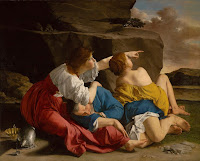Archaeologist Discover the cave where Lot hid with his daughters.
The book of Genesis covers a greater time period and more information than any other book of the Bible. One episode contained in the book of Genesis is the story of Sodom and Gomorrah. In the story we are told God allowed Lot and his family to escape the devastation and flee to the city of Zoar, current day Ghor al-Safi. Lot and his two daughters then took refuge in a cave as burning sulfur rained down, destroying the cities of Sodom and Gomorrah as well as their inhabitants. While debate continues over the destruction and even the existence of Sodom and Gomorrah, there have been remarkable discoveries concerning the possible location of Lot’s hiding place and the historical accuracy of Lot and his ordeal.
"Now Lot went up from Zoar with his two daughters and stayed in the mountains, because he was afraid to stay in Zoar; and he stayed in a cave, he and his two daughters." - Genesis 19:30
In 1986 an archeological survey south of the Dead Sea unearthed a cave. Within twelve months the site was identified as Deir Ain Abata — Monastery of the Abbot’s Spring — and a team of archeologists were assigned to the site. After further research and excavations a basilica was discovered. The basilica was built around the entrance to the cave, obviously placing the cave as the center-point of the structure. The floors were covered with white marble tiles and several mosaics were also found which offered evidence of the construction of the basilica, and its purpose.
A total of four mosaics were discovered. One of the mosaics consisted of six lines of text which listed names of key people of the time such as the Bishop and the Governor. It also provided a date of May, 691 A.D. and describes the basilica as a Holy Place, which indicates it was believed to be directly associated with a Biblical episode.
Several other blocks were found inscribed mostly in Greek. One block asked for the blessing of Saint Lot. This block, inscribed by three monks, was the first evidence the cave and surrounding basilica were associated with the biblical figure of Lot.
The entrance to the cave opened to a series of steps leading down to a small 2 by 2.5 meter room (6.5 feet by 8.2 feet). The floors here too were white marble and according to evidence found in the room and in the basilica above, this small room was were Lot and his daughters were believed to have sought refuge.
Research and further archeological evidence discovered at the sight places the original construction date of the basilica near 605 A.D. Archeologist were able to dig beneath the floor from the cave’s entrance and discovered additional artifacts. There were several layers of artifacts un-earthed dating from the 6th century A.D all the way back to 3300 B.C.
Given the fact the structure was identified as a basilica indicates it was larger than the average church and would have been capable of accommodating pilgrims. This is considered further evidence of the sights perceived significance. An inscription notes renovations were completed on the structure in 691 A.D. and was abandoned at some point after this date. The structure was in excellent condition when discovered which leads researchers to believe it was peacefully abandoned. It is theorized a small portion of the structure as well as a garden area slide down the hillside in an earthquake. This may have lead to a fear the remaining facility was unstable and thus abandoned.
The inscriptions and carvings clearly show the sixth century monks believed this to be the cave of Lot and his two daughters. Why this cave was selected over several others in the area is unclear. It is largely believed local oral tradition identified the cave as Lot’s sanctuary and a holy place well before the construction of the basilica. There were additional Arabic inscriptions found at the site dating to the ninth century. This leads some researchers to surmise there was a Muslim interest in the area as well. (Lot is considered a prophet in the Koran.)
Much of the work on the basilica was completed during the period of the Umayyad Dynasty which ended in 750 A.D. It is commonly believed the Umayyad were tolerant of different religions. It is possible the site had long been considered the location where Lot took refuge but the basilica could not be constructed until the political climate permitted.
Evidence shows the cave was occupied, at least periodically, for thousands of years. Artifacts and archeological evidence also make it clear the builders of the basilica believed the site to indeed be the cave mentioned in the Bible in which Lot hid with his daughters. While calling this a confirmation for the existence of the Biblical figure of Lot would be inappropriate given the data, it certainly offers some evidence to show Lot, his place of hiding, and his biblical story as being potentially historically accurate.
Did you enjoy this article? Follow this Blog to get new posts sent to you.


Comments